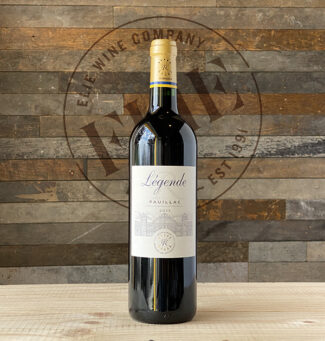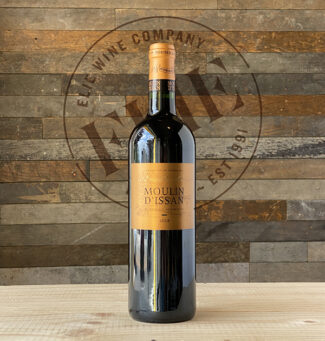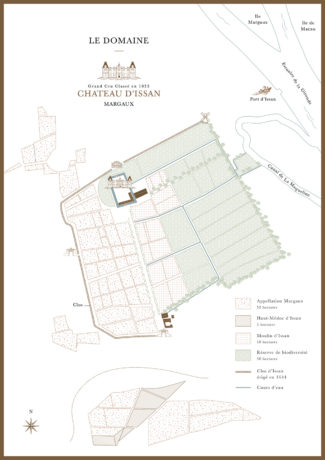The Case for Bordeaux Top Classified Châteaux’ Third Wines (9-Bottle Wine-Pack $275, All Included)
The great estates of Bordeaux first began to release second label wines in the 17th century, and although they have traditionally varied in price-to-value ratio, it is a logical way for these highly-prized properties to be flexible in their output and to promote their Grand Vin while offering a representational alternative at a lower cost. For consumers, B-List wines from top châteaux often offer a couple of practical advantages that their big-shouldered brothers cannot: Affordability and accessibility in their youth.
Second label wines are not to be confused with the 2nd Growth wines from the historic 1855 Bordeaux Classification like Château Rauzan-Ségla and Château Léoville Las Cases. Second labels are made as separate cuvées within Classified Growths (Crus), often serving as a commercial repository for fruit from declassified lots or slightly Brix-challenged grapes. Throughout Bordeaux, the offerings of second labels attached to grand châteaux is pretty well represented, so what would be the purpose—let alone the incentive—of introducing a third label? Especially since additional labels also require clever new business strategies to separate them from the pack in the eye of the consumer?
That’s a question answered in part by a decade’s worth of physical expansion among several of the Left Bank’s most highly-prized châteaux. New vines have been planted in new terroirs that may take decades to reach maturity. Despite exceptional soils, these very young vines are not yet producing fruit worthy of even a château’s second wine, since the selection process these latter wines has become more rigorous in recent years. Second label wines have undergone an effort to improve quality while third labels offer a showcase for younger wines. As a general rule, the objective for a third label is the same as that one used for the second labels: To produce wines displaying some of the characteristics of their top-tier parents, but at a much more affordable rate. Not only that, but these are intended to be ‘now’ wines, meant for tonight’s dinner table rather than the cellar. It is a way for fans of the great estates to absorb some of the magic without having to attend an auction or spend the kids’ college fund to buy a wine that won’t even be ready to drink until they’ve already graduated college.
Among the third label wines offered in this all-inclusive 9-bottle set are 3 bottles of Légende R from the iconic Château Lafite-Rothschild (Pauillac) and 6 bottles of Moulin d’Issan from Château d’Issan (Margaux) for $275. Both labels represent the two Holy Grails of budget-minded Bordeaux lovers: Value and promise.
 Château Lafite-Rothschild (Pauillac) First Growth
Château Lafite-Rothschild (Pauillac) First Growth
Although there were vineyards at Pauillac’s iconic estate long before Thomas Jefferson stopped by, it was his high regard for the property (coupled with the fact that it was King Louis XV’s favorite wine) that secured Lafite-Rothschild’s spot in the world’s wine stage. Boasting a unique terroir characterized by gravelly hilltops atop clay subsoil, Lafite’s vineyards offer natural drainage and ideal conditions for growing superior Cabernet Sauvignon. As is often the case when the stars align over a vineyard, vintage bottles of Lafite are among the priciest wines in the world, and even the second label, Carruades de Lafite, generally sells for hundreds of dollars. But the third label, Légende R, Pauillac 2014, is available for $42. According to Légende’s winemaker Diane Flamand, “Whether it is our Grand Vin, our Carruades, or Légende, the goal at Lafite is the same: We are after balance, elegance and structure.”
Légende R is created from select plots of younger vines on the Lafite estate, and vinified using both traditional Bordeaux technique and with the characteristic attention to detail. A spicy, white-pepper intensity rises from the glass, filled with layers of fig and red fruit and complemented by chocolate, licorice and roasted espresso beans. The wine is supple and full, rich with sweet plum and opulent cherry. Drinkable upon release, this is a ‘discovery’ wine that combines some of the most notable characteristics of its prestigious parent, but in a decidedly less concentrated package.
 Château d’Issan (Margaux) Third Growth
Château d’Issan (Margaux) Third Growth
Among the appellations of Bordeaux, Margaux is renowned for the elegant structure and velvety-soft flavors of its wine. Château d’Issan in particular benefits from a mild climate, gravelly soil and alluvial hills; perfect for creating wines exemplary of the region.
Geography is destiny, and nowhere is this more obvious than along the historic d’Issan path that passes heads toward the Gironde Estuary; the Margaux vineyards and the Bordeaux Supérieur appellation plots are contiguous, with the vines near the river rising from soil that is mainly clay and limestone, and therefore, well-suited to the Merlot. Like the famous Moulin Rouge dance hall in the 18th arrondissement, Château d’Issan’s third label, Moulin d’Issan, Bordeaux Supérieur 2018 ($22) takes its name from a windmill that still sits on the estate and where the wine is made. Merlot represents 90% of the composition, which makes it unique in Margaux, where wines are predominately Cabernet Sauvignon. Silken and sweet, the wine is gentle on the nose and shows tart cherry and raspberry with an underflow suggesting tobacco leaf and integrated chocolate notes. It’s mouth-filling and briefly luscious, offering the trademark Château d’Issan Margaux framework at a fraction of the cost.

- - -
Posted on 2021.03.18 in France, Bordeaux
Featured Wines
- Notebook: A’Boudt Town
- Saturday Sips Wines
- Saturday Sips Review Club
- The Champagne Society
- Wine-Aid Packages
Wine Regions
Grape Varieties
Aglianico, Albarino, Albarín Blanco, Albarín Tinto, Albillo, Aleatico, Arbanne, Aubun, Barbarossa, barbera, Beaune, Biancu Gentile, bourboulenc, Cabernet Franc, Cabernet Sauvignon, Caino, Caladoc, Calvi, Carcajolu-Neru, Carignan, Chablis, Chardonnay, Chasselas, Clairette, Corvina, Cot, Counoise, Erbamat, Ferrol, Fiano, Frappato, Friulano, Fromenteau, Fumin, Garnacha, Gewurztraminer, Godello, Graciano, Grenache, Grolleau, Groppello, Juan Garcia, Lambrusco, Loureira, Macabeo, Macabou, Malvasia, Malvasia Nera, Marsanne, Marselan, Marzemino, Melon de Bourgogne, Merlot, Mondeuse, Montanaccia, Montepulciano, Morescola, Morescono, Moscatell, Muscadelle, Muscat, Natural, Nero d'Avola, Parellada, Patrimonio, Petit Meslier, Petit Verdot, Pineau d'Aunis, Pinot Auxerrois, Pinot Blanc, Pinot Gris, Pinot Meunier, Pinot Noir, Poulsard, Prieto Picudo, Rondinella, Rousanne, Roussanne, Sangiovese, Sauvignon Blanc, Savignin, Semillon, Souson, Sparkling, Sumoll, Sylvaner, Syrah, Tannat, Tempranillo, Trebbiano, Trebbiano Valtenesi, Treixadura, Trousseau, Ugni Blanc, vaccarèse, Verdicchio, Vermentino, Viognier, Viura, Xarel-loWines & Events by Date
- April 2024
- March 2024
- February 2024
- January 2024
- December 2023
- November 2023
- October 2023
- September 2023
- August 2023
- July 2023
- June 2023
- May 2023
- April 2023
- March 2023
- February 2023
- January 2023
- December 2022
- November 2022
- October 2022
- September 2022
- August 2022
- July 2022
- June 2022
- May 2022
- April 2022
- March 2022
- February 2022
- January 2022
- December 2021
- November 2021
- October 2021
- September 2021
- August 2021
- July 2021
- June 2021
- May 2021
- April 2021
- March 2021
- February 2021
- January 2021
- December 2020
- November 2020
- October 2020
- September 2020
- August 2020
- July 2020
- June 2020
- May 2020
- April 2020
- March 2020
- February 2020
- January 2020
- December 2019
- November 2019
- October 2019
- September 2019
- August 2019
- July 2019
- June 2019
- May 2019
- April 2019
- March 2019
- February 2019
- January 2019
- December 2018
- November 2018
- October 2018
- September 2018
- August 2018
- July 2018
- June 2018
- May 2018
- April 2018
- March 2018
- February 2018
- January 2018
- December 2017
- November 2017
- October 2017
- September 2017
- August 2017
- July 2017
- June 2017
- May 2017
- April 2017
- March 2017
- February 2017
- January 2017
- December 2016
- November 2016
- October 2016
- September 2016
- August 2016
- July 2016
- June 2016
- May 2016
- April 2016
- March 2016
- February 2016
- January 2016
- December 2015
- November 2015
- October 2015
- September 2015
- August 2015
- July 2015
- June 2015
- May 2015
- April 2015
- March 2015
- February 2015
- January 2015
- December 2014
- November 2014
- October 2014
- September 2014
- August 2014
- July 2014
- June 2014
- April 2014
- March 2014
- February 2014
- January 2014
- December 2013
- November 2013
- October 2013
- September 2013
- August 2013
- July 2013
- June 2013
- May 2013
- April 2013
- March 2013
- February 2013
- January 2013
- December 2012
- November 2012
- October 2012
- February 2004
Search



